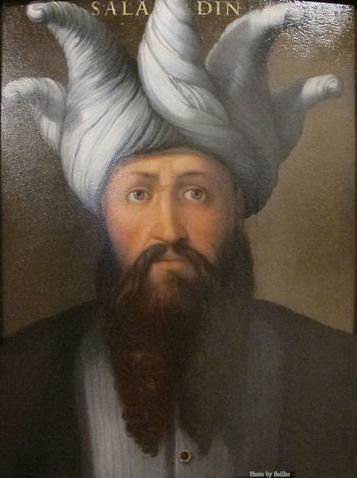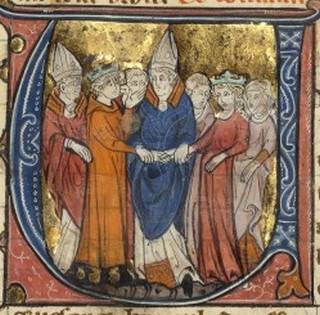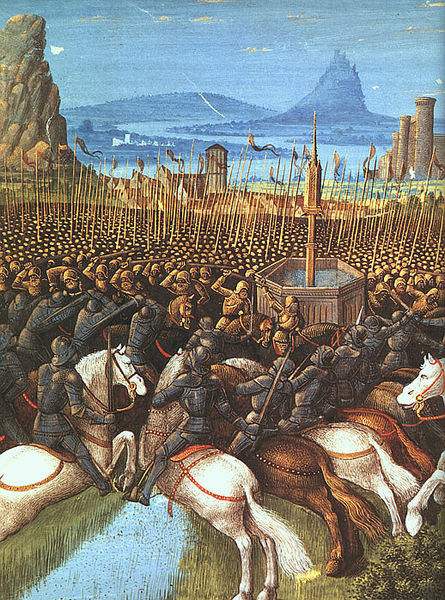II. Foundation of Christian states in the East;
III. FIRST DESTRUCTION OF THE CHRISTIAN STATES (1144-87)
Many dangers, unfortunately, threatened this prosperity. On the south were the Caliphs of Egypt, on the east the Seljuk Ameers of Damascus, Hamah and Aleppo, and on the north the Byzantine emperors, eager to realize the project of Alexius Comnenus and bring the Latin states under their power. Moreover, in the presence of so many enemies the Christian states lacked cohesion and discipline. The help they received from the West was too scattered and intermittent. Nevertheless these Western knights, isolated amid Mohammedans and forced, because of the torrid climate, to lead a life far different from that to which they had been accustomed at home, displayed admirable bravery and energy in their efforts to save the Christian colonies.
In 1137 John Comnenus, Emperor of Constantinople, appeared before Antioch with an army, and compelled Prince Raymond to do him homage. On the death of this potentate (1143), Raymond endeavoured to shake off the irksome yoke and invaded Byzantine territory, but was hemmed in by the imperial army and compelled (1144) to humble himself at Constantinople before the Emperor Manuel. The Principality of Edessa, completely isolated from the other Christian states, could not withstand the attacks of Imad-ed-Din, the prince, or atabek, of Mosul, who forced its garrison to capitulate 25 December, 1144. After the assassination of Imad-ed-Din, his son Nour-ed-Din continued hostilities against the Christian states. At news of this, Louis VII of France, Queen Eleanor of Aquitaine, and a great number of knights, moved by the exhortations of St. Bernard, enlisted under the cross (Assembly of Vézelay, 31 March, 1146). The Abbot of Clairvaux became the apostle of the crusade and conceived the idea of urging all Europe to attack the infidels simultaneously in Syria, in Spain, and beyond the Elbe.
At first he met with strong opposition in Germany. Eventually Emperor Conrad III acceded to his wish and adopted the standard of the cross at the Diet of Spires, 25 December, 1146. However, there was no such enthusiasm as had prevailed in 1095. Just as the crusaders started on their march, King Roger of Sicily attacked the Byzantine Empire, but his expedition merely checked the progress of Nour-ed-Din’s invasion. The sufferings endured by the crusaders while crossing Asia Minor prevented them from advancing on Edessa. They contented themselves with besieging Damascus, but were obliged to retreat at the end of a few weeks (July, 1148). This defeat caused great dissatisfaction in the West; moreover, the conflicts between the Greeks and the crusaders only confirmed the general opinion that the Byzantine Empire was the chief obstacle to the success of the Crusades. Nevertheless, Manuel Comnenus endeavoured to strengthen the bonds that united the Byzantine Empire to the Italian principalities. In 1161 he married Mary of Antioch, and in 1167 gave the hand of one of his nieces to Amalric, King of Jerusalem. This alliance resulted in thwarting the progress of Nour-ed-Din, who, having become master of Damascus in 1154, refrained thenceforth from attacking the Christian dominions.
King Amalric profited by this respite to interpose in the affairs of Egypt, as the only remaining representatives of the Fatimite dynasty were children, and two rival viziers were disputing the supreme power amid conditions of absolute anarchy. One of these disputants, Shawer, being exiled from Egypt, took refuge with Nour-ed-Din, who sent his best general, Shírkúh, to reinstate him. After his conquest of Cairo, Shírkúh endeavoured to bring Shawer into disfavour with the caliph; Amalric, taking advantage of this, allied himself with Shawer. On two occasions, in 1164 and 1167, he forced Shírkúh to evacuate Egypt; a body of Frankish knights was stationed at one of the gates of Cairo, and Egypt paid a tribute of 100,000 dinárs to the Kingdom of Jerusalem. In 1168 Amalric made another attempt to conquer Egypt, but failed. After ordering the assassination of Shawer, Shírkúh had himself proclaimed Grand Vizier. At his death on 3 March, 1169, he was succeeded by his nephew, Salah-ed-Dîn (Saladin). During that year Amalric, aided by a Byzantine fleet, invaded Egypt once more, but was defeated at Damietta. Saladin retained full sway in Egypt and appointed no successor to the last Fatimite caliph, who died in 1171. Moreover, Nour-ed-Din died in 1174, and, while his sons and nephews disputed the inheritance, Saladin took possession of Damascus and conquered all Mesopotamia except Mosul.

Painting of Saladin by Cristofano dell’Altissimo. At the Battle of Hattin, 200 knights of the Templar and Hospitaller Military Orders who were taken prisoner were beheaded at Saladin’s orders, with the exception of the Grand Master of the Temple. According to his secretary, Saladin, “his face joyful, was sitting on his dais”, while he watched each of his men take a turn in beheading each of the Crusaders. The relic of the True Cross, which was captured in the battle, was fixed upside down on a lance and sent to Damascus.
Thus, when Amalric died in 1173, leaving the royal power to Baldwin IV, “the Leprous”, a child of thirteen, the Kingdom of Jerusalem was threatened on all sides. At the same time two factions, led respectively by Guy de Lusignan, brother-in-iaw of the king, and Raymond, Count of Tripoli, contended for the supremacy. Baldwin IV died in 1184, and was soon followed to the grave by his nephew Baldwin V. Despite lively opposition, Guy de Lusignan was crowned king, 20 July, 1186. Though the struggle against Saladin was already under way, it was unfortunately conducted without order or discipline. Notwithstanding the truce concluded with Saladin, Renaud de Châtillon, a powerful feudatory and lord of the trans-Jordanic region, which included the fief of Montréal, the great castle of Karak, and Aïlet, a port on the Red Sea, sought to divert the enemy’s attention by attacking the holy cities of the Mohammedans. Oarless vessels were brought to Aïlet on the backs of camels in 1182, and a fleet of five galleys traversed the Red Sea for a whole year, ravaging the coasts as far as Aden; a body of knights even attempted to seize Medina.
In the end this fleet was destroyed by Saladin’s, and, to the great joy of the Mohammedans, the Frankish prisoners were put to death at Mecca. Attacked in his castle at Karak, Renaud twice repulsed Saladin’s forces (1184-86). A truce was then signed, but Renaud broke it again and carried off a caravan in which was the sultan’s own sister. In his exasperation Saladin invaded the Kingdom of Jerusalem and, although Guy de Lusignan gathered all his forces to repel the attack, on 4 July, 1187, Saladin’s army annihilated that of the Christians on the shores of Lake Tiberias. The king, the grand master of the Temple, Renaud de Châtillon, and the most powerful men in the realm were made prisoners. After slaying Renaud with his own hand, Saladin marched on Jerusalem. The city capitulated 17 September, and Tyre, Antioch, and Tripoli were the only places in Syria that remained to the Christians.
LOUIS BRÉHIER (Catholic Encyclopedia)
II. Foundation of Christian states in the East;
III. First destruction of the Christian states (1144-87);














